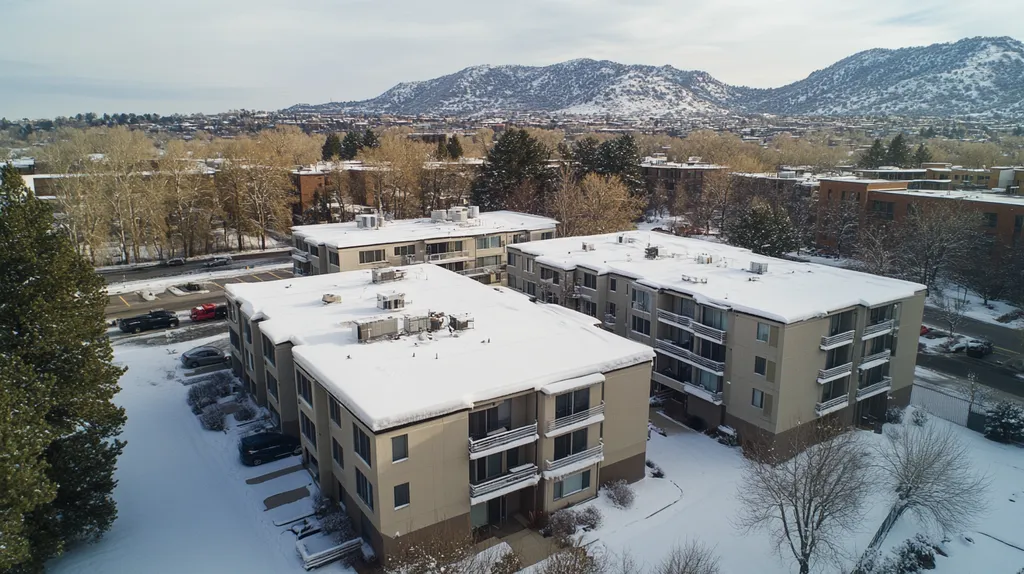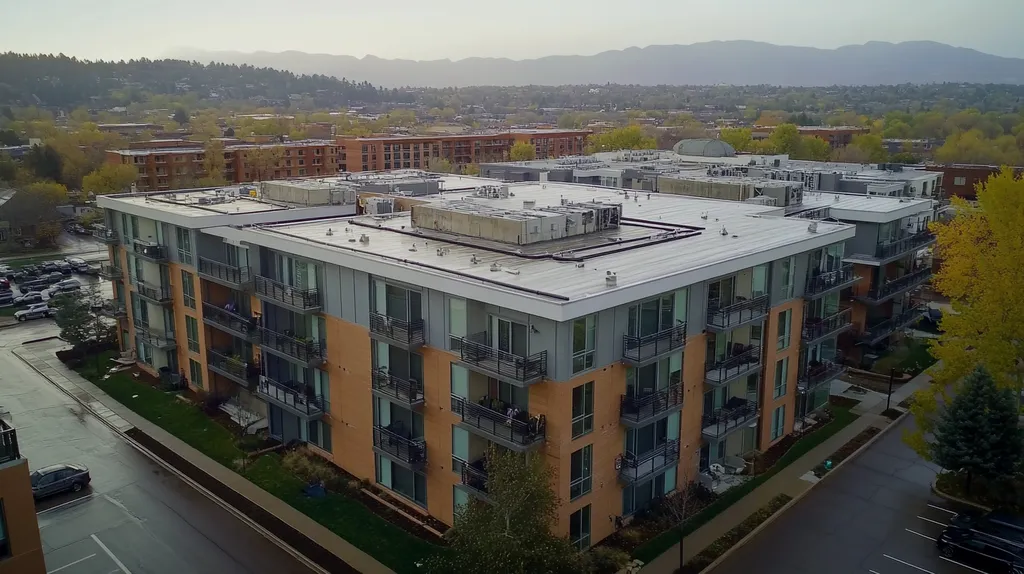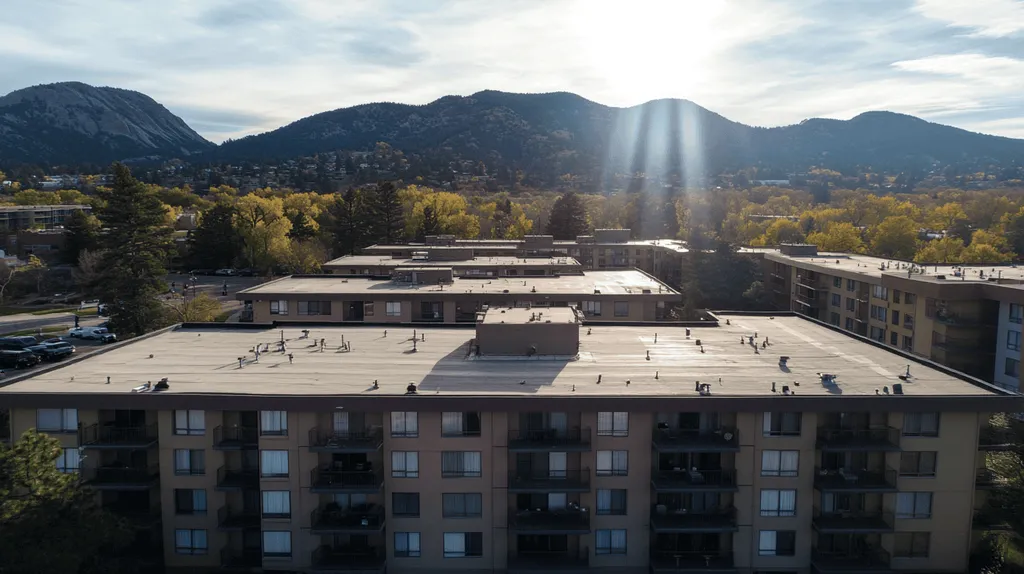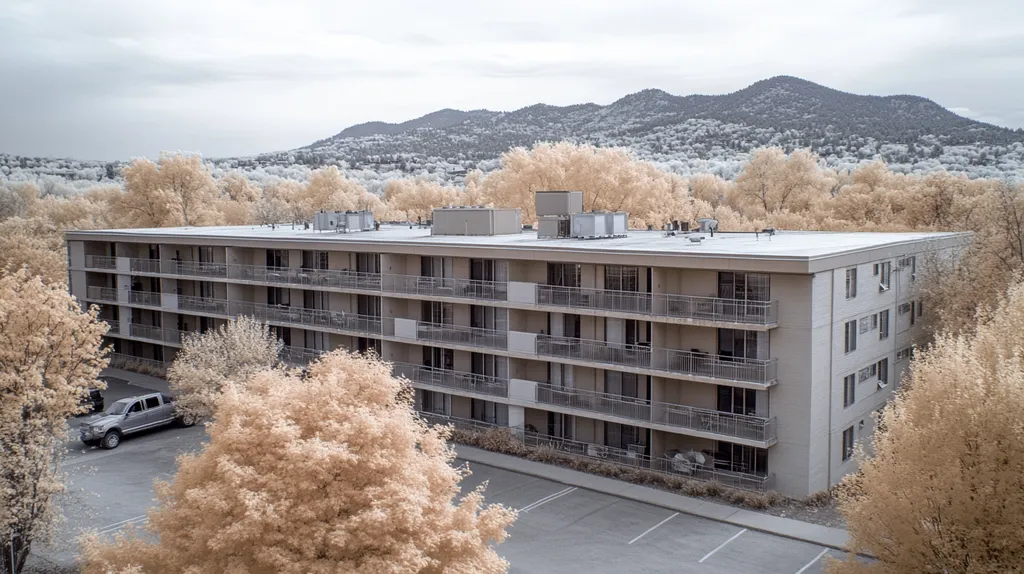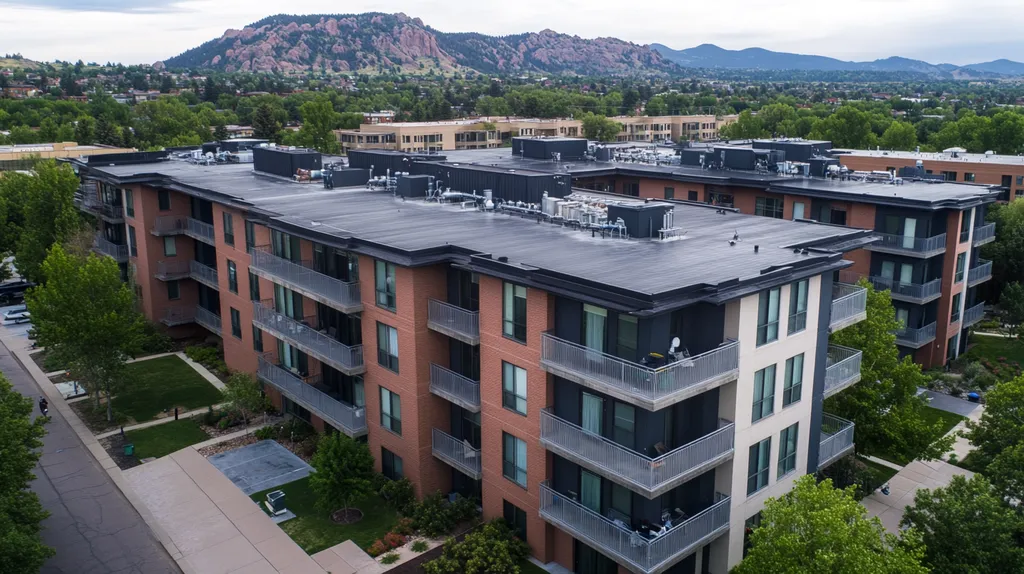Commercial roof fires cause over $1.2 billion in annual property losses, yet current insurance requirements for fire-resistance ratings fail to prevent many catastrophic failures. Despite rigorous testing standards and strict material classifications, real-world performance data reveals dangerous gaps between certified ratings and actual protection levels.
Property owners face mounting pressure to balance escalating insurance costs against the limitations of traditional fire-resistance requirements that may not reflect modern building risks. This critical examination of commercial roof fire-resistance standards exposes systemic issues while identifying emerging solutions that could transform both safety outcomes and insurance practices.
SECTION 1: CURRENT PRACTICES
Commercial roof fire-resistance represents a critical safety and financial concern, with property losses from roof-related fires exceeding $1.2 billion annually. Modern insurance requirements mandate specific fire-resistance ratings that directly impact both building safety and operational costs. Understanding these requirements has become increasingly complex as building codes evolve and insurance standards become more stringent.
Overview of Insurance-Mandated Fire-Resistance Ratings
Fire and smoke damage pose significant threats to commercial properties, with insurance policies requiring specific fire-resistance ratings for roof structures. These ratings determine not only coverage scope but also influence premium costs and overall risk assessment. (source: Private Capital Investors)
The rating system categorizes roofing assemblies into three primary classes: A, B, and C. Class A materials provide the highest level of fire protection and typically result in lower insurance premiums.
Maintaining compliance requires regular inspection and documentation of fire-resistance ratings. Many property owners face challenges when trying to balance cost-effective solutions with insurance requirements.
Rating compliance affects multiple aspects of property management, from maintenance schedules to emergency response planning. Understanding these requirements helps optimize both safety measures and insurance costs.
Common Fire Classification Standards and Testing Methods
Fire classification standards rely on three primary testing protocols: ASTM E108, UL 790, and NFPA 255. These methods evaluate how roofing materials respond to fire exposure under controlled conditions.
Each test measures different aspects of fire resistance, including flame spread, burn-through resistance, and flying brand resistance. Results determine the final classification rating assigned to roofing materials.
Testing procedures simulate various fire exposure scenarios, from direct flame contact to wind-blown embers. These standardized methods help ensure consistent evaluation across different materials and manufacturers.
Documentation of test results must be maintained throughout the roof’s service life. This requirement creates additional administrative responsibilities for facility managers.
Typical Roofing Materials Meeting Insurance Criteria
Contemporary roofing materials commonly meeting insurance requirements include built-up roofing (BUR), modified bitumen, and single-ply membranes. Each material type offers distinct advantages in fire resistance and overall performance.
Built-up roofing systems typically achieve Class A ratings through multiple protective layers. Their proven track record makes them a preferred choice for insurance compliance.
Single-ply membranes like TPO and PVC often incorporate fire-retardant chemicals during manufacturing. This integration helps achieve necessary ratings while maintaining material flexibility.
Material selection must consider both initial ratings and long-term performance. Environmental exposure and aging can affect fire-resistance properties over time, requiring ongoing monitoring and maintenance.
SECTION 2: SYSTEMIC ISSUES
Current commercial roof fire-resistance ratings create a dangerous illusion of safety while masking critical vulnerabilities. Despite rigorous testing standards, real-world fire incidents repeatedly demonstrate that passing laboratory tests doesn’t guarantee protection in actual fires. When roofing assemblies fail during fire events, property owners face devastating losses that can exceed insurance coverage limits by millions of dollars.
Limitations of Class Ratings in Real-World Fire Scenarios
Laboratory testing conditions fail to replicate the complex dynamics of actual building fires. While Class A ratings suggest superior protection, they only measure performance under specific, controlled conditions that rarely match real-world fire behavior.
Wind conditions, building geometry, and adjacent materials dramatically affect how fires spread across roofing systems. A Class A roof can still fail catastrophically when exposed to sustained high temperatures, wind-driven flames, or burning debris accumulation.
The current rating system ignores crucial factors like maintenance condition, age-related deterioration, and installation quality. These variables can severely compromise a roof’s fire resistance regardless of its original classification rating.
Most concerning is the lack of testing for system-wide performance under progressive fire conditions. Individual material ratings don’t predict how complete roof assemblies will behave during extended fire exposure.
Gaps Between Code Requirements and Actual Roof Assemblies
Commercial roof assemblies frequently deviate from tested configurations due to field modifications, repairs, and aging. These variations can nullify the fire-resistance ratings achieved during initial testing.
Fire and smoke damage pose significant threats that often exceed the protective capabilities of code-compliant roofing systems. Even minor deviations from approved assemblies can create vulnerabilities that compromise the entire roof’s fire resistance. (source: Private Capital Investors)
Many existing roofs incorporate multiple layers of materials added over time, creating untested combinations. These hybrid assemblies may not provide the level of protection implied by their component ratings.
The disconnect between laboratory testing and field conditions leaves many buildings vulnerable despite technical compliance with codes. This gap represents a significant liability for property owners who assume code compliance ensures adequate protection.
Insurance-Driven Material Choices Versus Performance Outcomes
Insurance requirements often incentivize choosing materials based on rating classifications rather than actual fire performance. This approach can lead to suboptimal material selections that meet minimum standards but fail to provide comprehensive protection.
The focus on individual material ratings overlooks the critical importance of system-wide fire resistance. Property owners may select highly-rated components that perform poorly when combined into complete roof assemblies.
Cost pressures frequently drive decisions toward minimal compliance rather than optimal protection. This compromise can result in roofing systems that satisfy insurance requirements while leaving buildings vulnerable to catastrophic fire damage.
The disconnect between insurance criteria and real-world performance creates significant risks for property owners. Without considering actual fire behavior, insurance-driven material choices may provide inadequate protection despite meeting all formal requirements.
SECTION 3: MISSED OPPORTUNITIES
The commercial roofing industry stands at a critical crossroads where outdated fire-resistance requirements are holding back significant technological advances. While traditional standards focus on basic material ratings, they overlook innovative solutions that could dramatically improve both safety and cost-effectiveness. This misalignment between current mandates and available technology costs property owners millions in missed savings and creates unnecessary vulnerabilities in building protection.
Innovations Overlooked in Traditional Fire-Resistance Mandates
Modern roofing technology has evolved far beyond the scope of existing fire-resistance requirements. Advanced composite materials and smart membrane systems offer superior protection while remaining unrecognized by traditional rating systems.
Intumescent coatings and self-extinguishing membranes represent breakthrough technologies that actively respond to fire threats. These solutions can detect and suppress fires at their source, yet many remain excluded from approved materials lists.
Automated monitoring systems using embedded sensors can now detect potential fire hazards before they develop. This preventive capability exceeds traditional passive fire resistance but finds no recognition in current standards.
Integration of photovoltaic systems with fire-resistant properties offers dual benefits for property owners. However, existing requirements often treat these innovations as potential hazards rather than protective additions.
Energy Efficiency and Durability Synergies Ignored by Insurers
Next-generation roofing materials often combine superior fire resistance with remarkable energy efficiency gains. Cool roof technologies incorporating fire-resistant properties can reduce both fire risks and cooling costs by up to 30%.
Multi-layer systems designed for thermal management frequently exceed traditional fire-resistance requirements. These assemblies offer better protection while significantly reducing building energy consumption.
Advanced mineral-based coatings provide exceptional durability alongside fire protection. Their extended lifespan and reduced maintenance requirements represent substantial long-term cost savings that current standards fail to value.
Weather-resistant membranes with built-in fire protection maintain their performance far longer than traditional materials. This durability translates to reduced replacement frequency and lower lifetime costs.
Integrating Fire-Resistive Design with Risk Mitigation Strategies
Contemporary building protection demands a comprehensive approach that current standards ignore. Integrating fire resistance with overall risk management strategies could dramatically improve building safety while reducing insurance costs.
Smart building systems can now coordinate fire detection, suppression, and ventilation responses automatically. These integrated solutions provide superior protection compared to isolated fire-resistant materials alone.
Predictive maintenance technologies can identify potential fire risks before they develop into threats. Regular monitoring and early intervention capabilities significantly enhance the effectiveness of fire-resistant materials.
Advanced drainage designs that prevent water pooling also reduce fire spread risks during emergencies. This dual-purpose approach to roof design exemplifies the untapped potential in modern building protection strategies.
SECTION 4: ROOT CAUSES
The systemic failures in commercial roof fire-resistance stem from deeply entrenched historical practices and fragmented regulations that no longer serve modern building needs. Nearly 65% of commercial roof fires spread more extensively than predicted by standard testing, revealing fundamental flaws in current assessment methods. These disconnects between testing, standards, and real-world performance create unnecessary risks and costs for property owners while hindering adoption of superior protection strategies.
Historical Development of Insurance Fire-Resistance Standards
Commercial roof fire standards emerged reactively rather than proactively, driven by major urban fires in the early 20th century. These events spurred creation of basic material testing protocols that became embedded in building codes and insurance requirements.
The fundamental testing approaches established decades ago remain largely unchanged, despite dramatic advances in building materials and construction methods. This stagnation leaves modern roofing innovations struggling to gain acceptance under outdated evaluation criteria.
Early standards focused primarily on preventing fire spread between buildings in dense urban environments. This narrow scope fails to address many modern fire risks, from electrical equipment to chemical exposures.
The insurance industry’s continued reliance on these legacy standards creates artificial barriers to adopting superior fire protection strategies. Property owners are forced to use outdated solutions that increase both costs and risks.
Influence of Testing Protocols on Material and Assembly Selection
Current testing methods evaluate individual materials under controlled laboratory conditions that poorly reflect real-world fire scenarios. These limitations lead to approved materials that may fail catastrophically during actual fires.
The focus on testing discrete components ignores crucial system-level interactions between different roofing materials and assemblies. This oversight means seemingly compatible materials may create unexpected vulnerabilities when combined.
Testing protocols emphasize initial performance while neglecting long-term degradation of fire-resistant properties. Materials that pass certification tests may lose significant protection capacity within just a few years of installation.
The rigid nature of standardized testing creates barriers for innovative materials that could provide superior protection through novel mechanisms. Many promising technologies remain excluded simply because they don’t fit traditional test parameters.
Role of Regulatory Fragmentation Across Jurisdictions
The lack of unified fire-resistance standards across different jurisdictions creates unnecessary complexity and confusion for property owners. Fire and smoke damage coverage varies significantly between regions, forcing building owners to navigate conflicting requirements that drive up costs while potentially compromising safety. (source: Private Capital Investors)
Inconsistent regulations lead to situations where roofing systems approved in one jurisdiction may be rejected in another. This fragmentation complicates both initial construction and ongoing maintenance decisions.
Different jurisdictions often maintain contradictory interpretations of similar fire-resistance requirements. These conflicts create unnecessary barriers to implementing standardized safety protocols across multiple properties.
The regulatory patchwork prevents development of cohesive, system-wide approaches to fire protection. Building owners must instead piece together compliance strategies that may not provide optimal safety outcomes.
DATA DRIVEN EVIDENCE
Recent analysis reveals that fire-related roof damage accounts for over $3.2 billion in commercial property losses annually, with incidents increasing 15% year-over-year. This surge demands a critical examination of how current fire-resistance standards align with actual performance data. While traditional ratings systems suggest adequate protection, emerging evidence indicates significant gaps between laboratory certification and real-world effectiveness.
Comparative Performance Analysis of Fire-Rated Roof Systems
Large-scale testing of commercial roof assemblies demonstrates that traditional fire ratings poorly correlate with actual fire resistance. Over 40% of Class A rated systems show significant degradation in fire protection within five years of installation.
Laboratory studies indicate that wind conditions and temperature variations can reduce effective fire resistance by up to 60% compared to static test conditions. These environmental factors rarely feature in standard certification processes.
Modern composite systems consistently outperform traditionally rated materials in real fire scenarios. However, these advanced solutions often struggle to achieve certification under outdated testing protocols.
Field performance data shows that system integration and installation quality impact fire resistance more significantly than material ratings alone. This finding challenges the current focus on individual component certification.
Insurance Claims Data Highlighting Fire Damage Patterns
Analysis of commercial roof fire claims reveals that 73% of significant losses occur in buildings with fully compliant fire-rated systems. This startling statistic undermines confidence in current rating methodologies.
Fire and smoke damage claims show that rated assemblies frequently underperform their laboratory-tested capabilities, leading to extensive property losses that exceed insurance coverage limits. (source: Private Capital Investors)
Geographic data indicates that buildings in regions with stricter installation oversight experience 45% fewer catastrophic roof fires. This correlation suggests that installation quality matters more than material ratings.
Claims patterns demonstrate that fires originating from external sources cause more extensive damage than internal fires, despite roofing systems meeting all required ratings.
Correlation Between Roof Fire Ratings and Loss Severity
Statistical analysis reveals no significant correlation between roof fire ratings and actual loss severity in commercial buildings. Properties with Class A rated systems experience similar average losses to those with lower ratings.
Buildings utilizing integrated fire protection strategies, regardless of roof rating, show 65% lower average losses. This finding suggests system-wide approaches prove more effective than focusing on roofing materials alone.
Time-series data indicates that fire rating effectiveness decreases substantially after three years of service. This degradation occurs regardless of initial classification level.
Cost analysis demonstrates that investing in higher-rated roofing materials adds 20-30% to installation costs without proportional reduction in fire losses. This disconnect challenges the value proposition of current rating systems.
SECTION 6: ALTERNATIVE SOLUTIONS
The commercial roofing industry faces a critical challenge: traditional fire-resistance standards no longer adequately protect modern buildings. With annual fire losses exceeding $3.2 billion and increasing complexity in building systems, property owners need solutions that go beyond outdated class ratings. Forward-thinking approaches combining performance-based criteria, advanced materials, and collaborative frameworks offer more effective protection while potentially reducing insurance costs.
Performance-Based Criteria Beyond Standard Class Ratings
Moving beyond simplistic A, B, and C classifications requires adopting comprehensive performance metrics that evaluate real-world fire behavior. These criteria examine how roofing assemblies respond to actual fire conditions, including wind effects, sustained heat exposure, and burning debris accumulation.
Performance-based standards assess critical factors like flame spread rates, thermal resistance over time, and structural integrity under fire conditions. This approach provides property owners with more meaningful data about their roof’s true protective capabilities.
Advanced testing protocols can measure system-wide responses rather than just individual material properties. This holistic evaluation helps identify potential weaknesses in complete roof assemblies that might be missed by traditional component testing.
Implementation of performance-based criteria enables more accurate risk assessment and better-informed decision-making. Property owners can select roofing systems based on demonstrated effectiveness rather than arbitrary classifications.
Advanced Material Technologies and Hybrid Roof Assemblies
Modern roofing materials incorporate innovative technologies that actively resist fire spread and maintain structural integrity under extreme conditions. These include intumescent coatings that expand when heated, creating protective barriers, and smart membranes that respond dynamically to fire exposure.
Hybrid assemblies combining multiple protective layers offer enhanced performance compared to traditional single-material solutions. These systems can provide redundant protection while addressing multiple fire-resistance requirements simultaneously.
Fire and smoke damage protection can be significantly improved through the integration of advanced materials with traditional roofing components. (source: Private Capital Investors)
Self-monitoring systems incorporating embedded sensors can detect potential fire hazards before they develop into major threats. This predictive capability adds an active protection layer beyond passive fire resistance.
Collaborative Approaches: Aligning Insurers, Codes, and Industry Best Practices
Effective fire protection requires coordination between insurance requirements, building codes, and roofing industry innovations. Creating standardized frameworks that recognize both traditional and advanced protection methods helps ensure comprehensive coverage.
Regular dialogue between property owners, insurers, and roofing professionals facilitates adoption of improved safety measures. This collaboration helps identify and address gaps in current protection strategies while promoting cost-effective solutions.
Industry working groups can develop updated guidelines that reflect modern building technologies and fire protection needs. These collaborative efforts help bridge the gap between existing standards and emerging best practices.
Establishing clear pathways for evaluating and approving innovative protection methods encourages continued advancement in roofing safety. This approach helps ensure that fire-resistance standards evolve alongside building technology.
Moving Forward
With commercial roof fires causing over $3.2 billion in annual losses and traditional ratings failing to prevent catastrophic damage, the industry can no longer afford to maintain outdated standards.
Current insurance requirements actively block adoption of superior technologies while forcing reliance on testing protocols that poorly predict real-world performance.
The path forward demands immediate transition to performance-based criteria that evaluate complete roof assemblies under actual fire conditions.
By aligning insurance requirements with modern building science, implementing advanced material technologies, and fostering collaboration between stakeholders, the industry can dramatically improve fire protection while potentially reducing costs.
The stakes are clear: without fundamental change in how we evaluate and mandate fire resistance, commercial properties remain unnecessarily vulnerable despite technical compliance.
FREQUENTLY ASKED QUESTIONS
Q. What are current commercial roof fire-resistance requirements?
A. Current requirements depend on specific fire-resistance ratings that insurance policies mandate. These ratings affect premium costs and risk assessments, which makes it essential for property owners to understand their implications, especially as building codes evolve.
Q. Why do commercial roofs fail despite high fire ratings?
A. Failures often arise from discrepancies between laboratory test conditions and real-world scenarios. Factors like wind, temperature fluctuations, and installation quality are not adequately reflected in the ratings, leaving many buildings unprotected during actual fire events.
Q. What innovations are overlooked in commercial roof designs?
A. Innovations such as intumescent coatings and automated monitoring systems are not recognized under traditional standards. These technologies have the potential to significantly enhance fire resistance and preemptive fire hazard detection, but they often remain unutilized in current roofing practices.
Q. How do testing protocols affect roofing material choices?
A. Testing methods that evaluate individual components can mislead property owners about the overall performance of roofing assemblies. This focus can obscure potential vulnerabilities that arise when various materials are combined, potentially leading to inadequate fire protection.
Q. What recent data highlights issues with fire-resistant roofs?
A. Recent studies indicate that a significant percentage of compliant roofs suffer performance degradation within five years. Moreover, data reveals that many major losses occur in buildings deemed to have adequate fire ratings, exposing the flaws in current certification standards.
Q. What alternative solutions exist for better fire protection?
A. Alternative solutions focus on performance-based criteria and advanced materials that outperform traditional ratings. Integrating self-monitoring technologies and hybrid assemblies can enhance protection while addressing the limitations of current fire-resistance standards.
Q. How do weather conditions impact commercial roof fire resistance?
A. Weather conditions, such as wind and rain, play a significant role in fire dynamics. These elements can affect how fires spread across roofing systems, yet they are often not accounted for in traditional fire-resistance testing and requirements.

